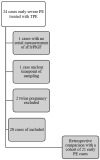Therapeutic Plasma Exchange in Early-Onset Preeclampsia: A 7-Year Monocentric Experience
- PMID: 37445324
- PMCID: PMC10342637
- DOI: 10.3390/jcm12134289
Therapeutic Plasma Exchange in Early-Onset Preeclampsia: A 7-Year Monocentric Experience
Abstract
Different therapeutic apheresis techniques have been clinically tested to delay preterm delivery in the case of eoPE (early-onset preeclampsia). Our study evaluated the feasibility of TPE (therapeutic plasma exchange) compared to standard-of-care treatment. Twenty patients treated with 95 TPE sessions were included in the final analysis and retrospectively matched with 21 patients with comparable placental dysfunction. Gestational age at admission was 23.75 ± 2.26 versus 27.57 ± 2.68 weeks of gestation (WoG) in the control group (p = < 0.001), mean sFlt-1/PlGF ratio was 1946.26 ± 2301.63 versus 2146.70 ± 3273.63 (p = 0.821) and mean sEng was 87.63 ± 108.2 ng/mL versus 114.48 ± 88.78 ng/mL (p = 0.445). Pregnancy was prolonged for 8.25 ± 5.97 days when TPE was started, compared to 3.14 ± 4.57 days (p = 0.004). The median sFlt-1/PlGF Ratio was 1430 before and 1153 after TPE (-18.02%). Median sEng fell from 55.96 ng/mL to 47.62 mg/mL (-27.73%). The fetal survival rate was higher in TPE-treated cases. NICU (Neonatal Intensive Center Unit) stay was in the median of 63 days in the TPE group versus 48 days in the standard-of-care group (p = 0.248). To date, this monocentric retrospective study, reports the largest experience with extracorporeal treatments in eoPE worldwide. TPE could improve pregnancy duration and reduce sFlt-1 and sEng in maternal serum without impairing neonatal outcomes.
Keywords: placental growth factor; preeclampsia; soluble endoglin; soluble fms-like tyrosine kinase 1; therapeutic plasma exchange.
Conflict of interest statement
All authors declare that the research was conducted without any commercial or financial relationships that could be construed as a potential conflict of interest.
Figures








References
-
- Brown M.A., Magee L.A., Kenny L.C., Karumanchi S.A., McCarthy F.P., Saito S., Hall D.R., Warren C.E., Adoyi G., Ishaku S., et al. Hypertensive Disorders of Pregnancy: ISSHP Classification, Diagnosis, and Management Recommendations for International Practice. Hypertension. 2018;72:24–43. doi: 10.1161/HYPERTENSIONAHA.117.10803. - DOI - PubMed
-
- Manuck T.A., Rice M.M., Bailit J.L., Grobman W.A., Reddy U.M., Wapner R.J., Thorp J.M., Caritis S.N., Prasad M., Tita A.T., et al. Preterm neonatal morbidity and mortality by gestational age: A contemporary cohort. Am. J. Obstet. Gynecol. 2016;215:103.e1–103.e14. doi: 10.1016/j.ajog.2016.01.004. - DOI - PMC - PubMed
-
- Bellamy L., Casas J.P., Hingorani A.D., Williams D.J. Pre-eclampsia and risk of cardiovascular disease and cancer in later life: Systematic review and meta-analysis. BMJ. 2007;335:974. doi: 10.1136/bmj.39335.385301.BE. - DOI - PMC - PubMed
LinkOut - more resources
Full Text Sources
Miscellaneous

